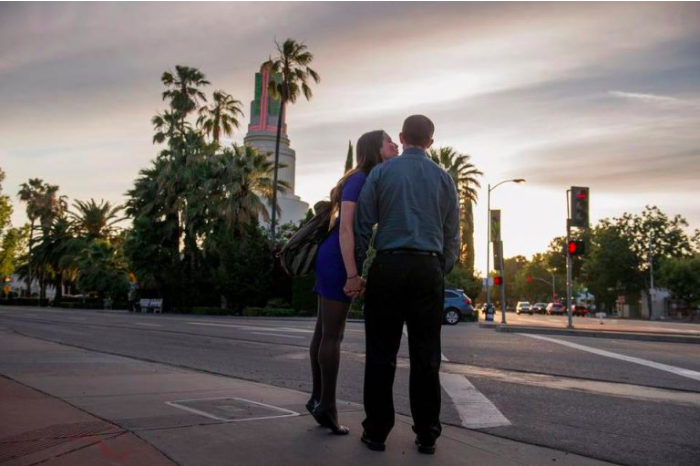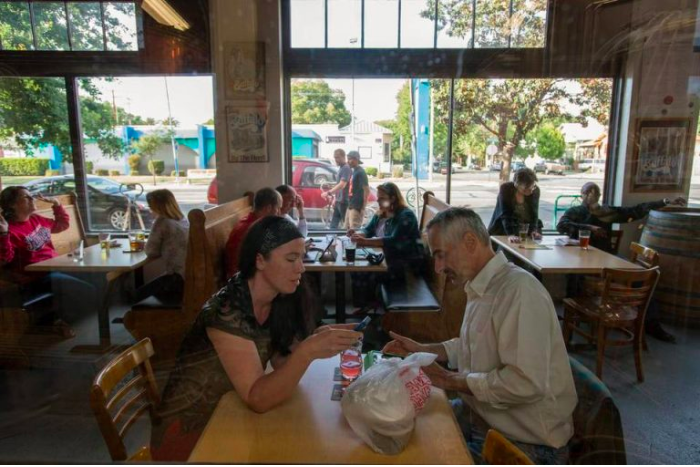May 14, 2014: Broadway Aims to Remake Itself

BY TONY BIZJAK tbizjak@sacbee.com
The west end of Broadway doesn’t look like much these days: a dead-end street with a smattering of old industrial buildings, drab storefronts and empty lots.
That forlorn appearance belies a budding renaissance that is expected to sweep much of the Broadway corridor from the Sacramento River to Highway 99 in the next few years, bringing a bustling Main Street feel back to one of the city’s original 1849 boulevards.
Last week, developers began pouring foundations for the first of what will be 1,000 town homes, bungalows and lofts on a 32-acre former lumber mill site near Interstate 5. The project, called The Mill at Broadway, is billed as a future home for young adults who want to walk to work downtown, and for baby boomers who might trade bigger Land Park houses and yards for a lock-and-leave lifestyle.
A few blocks east, redevelopment officials and private developers plan to tear down the World War II-era housing projects known as Marina Vista and Alder Grove, and replace them with a denser, mixed-income community. The public- private group is expected to brief the City Council on its plan later this month.
And restaurateur Randall Selland just announced he intends to move his upscale restaurant, The Kitchen, from the suburbs to an old supermarket site across Broadway from the old city cemetery – a move cheered up and down the corridor.
“It was location, location, location,” Selland said. “Honestly, we have been looking downtown to move The Kitchen for a couple of years, and really it’s the perfect location for what The Kitchen is and what people want from it.”
One of the most dramatic changes to Broadway’s ambiance may not come from what is built along it, but what happens to the street itself. Later this year, the city is expected to unveil plans to narrow the busy thoroughfare from two lanes in each direction to one, with some center turn lanes.
The idea, proponents say, is to transform what has become a dangerous, high-speed commuter cut-through into a tree- lined, small-town street where people can ride bikes and restaurants are willing to put tables out for sidewalk seating. The early reaction among business, property owners and nearby residents has been largely positive.
“I am quite excited about it; I’d be interested to see what traffic studies say,” said Land Park resident Ken Mennemeir, who sometimes rides bikes with his wife to Broadway restaurants, but seldom ventures onto the street itself because of traffic.
Mennemeir, president of the Land Park Community Association, said he hopes more private investors will be attracted to Broadway, to fix up the faded storefronts, turn old garages into new stores and businesses, and build on the many empty lots.
City Councilman Steve Hansen says he sees Broadway as the next major downtown corridor to modernize, after K Street and R Street.
“The opportunities really abound here,” he said. “You are starting, not with a blank canvas, but with an area that has been fragmented and overlooked for a long time.”
The street looks drab, but has good bones, and a notable pedigree. Originally built as Y Street, the southernmost street in the 1800s street grid, Broadway was widened into a major boulevard in the 1930s. It housed Edmonds Field, home of the professional baseball Solons team. It was the incubator for Russ Solomon’s international Tower Records. And it was once the car-cruising epicenter of the Sacramento Valley.
The art moderne Tower Theater, also built in the 1930s, remains a beacon. Tower Cafe and an eclectic row of international restaurants draw crowds from nearby Southside Park, midtown, Land Park, Curtis Park and beyond. And Broadway continues to host traditional neighborhood services that keep it relevant
– including banks, drugstores, auto shops, cafes – as well as the massive state Department of Motor Vehicles building and a Target store, each of which brings thousands of people daily to the boulevard.
But Broadway has stagnated. Some say construction of the W-X freeway in the 1960s, disconnecting Broadway from downtown, was a turning point.
“It just sort of sat there, and if things aren’t changing, they are usually going backwards,” said Jeff Setzer, whose family sold a chunk of its lumber mill site to Southern California investors for the current Mill at Broadway project.
The transformation of Broadway will not be quick. The city’s planned streetscape changes likely are still several years away. Other government-led corridor improvement projects down the road include building a bridge over the Sacramento River to West Sacramento, which is sprouting its own urban-style neighborhoods along the river. And, if city officials succeed in winning approval for a downtown streetcar line, that line may eventually be extended along Broadway and over the bridge to the Raley Field area in West Sacramento.
More immediately the arrival of the Mill project, The Kitchen restaurant announcement and some other recent business arrivals have cheered Broadway advocates, said Teresa Rocha, executive director of the Greater Broadway Partnership, a group that was formed a few years ago to help improve the area.
Rocha said she is seeing the early arrival of what she calls “creative class” businesses, attracted to the corridor by cheaper rents and the open-space industrial nature of some buildings.
McClatchy High School graduate Dave Gull, who hung out in younger days at the original Tower Records, is among the influential newcomers. Two years ago, Gull opened his own “homegrown thing,” New Helvetia Brewing Co., in a brick building at 18th Street and Broadway, turning the corner into a hot spot with locally brewed beer, food trucks and music.
“You have to work up the nerve, but I don’t feel like much of pioneer,” Gull said. “Broadway has had this amazing stability.”
The Sacramento Republic FC soccer team recently opened an office, team store and event space a block away on 17th Street. Team officials first looked for space in midtown, but chose the brick building off Broadway, partly because of aesthetics.
“We’re a startup, a very young group; the building we were in had to reflect our personality,” Republic vice president Erika Bjork said. “Being on Broadway, we can be a bit of a catalyst for the neighborhood.”
The company holds some meetings at Gull’s brewery a block away, she said. “We jokingly call New Helvetia our conference room.”
Tina Reynolds, owner of Uptown Studios Web design, marketing and social media consulting company, is joining the neighborhood soon. She will turn a warehouse into an event and party space.
“We are change agents,” Reynolds said. “We have a vision. I totally want to be here.”
Rocha and others say one hurdle Broadway faces is that many of the underdeveloped properties are owned by family trusts, with older family members unwilling to sell.
Architect Bill Harrell, a building owner on Broadway and a leading advocate for modernizing the street, has been approached by potential buyers recently. But he’s holding on for now, expecting real estate prices to rise.
“I’m not ready,” he said. “It’s too soon to be selling the building, unless you get an offer you can’t refuse.”
With growth, and the potential for outside investors, comes the concern that Broadway could lose its character as a neighborhood where people of different ages and cultures mix. But Rocha and local businesses with the Greater Broadway Partnership say they think there are enough local owners who are invested emotionally in the historic boulevard.
“There is a real sense of ownership,” Rocha said. We “want to make sure all of us – grandparents, children, families – can enjoy Broadway.”
Tony Bizjak: (916) 321-1059, @TonyBizjak

Rae Vander-Werf kisses David Hildebrand on the cheek as they wait for the light to change at 16th Street and Broadway in Sacramento across from the Tower Theater. Built in the 1930s, Tower Cafe and an eclectic row of international restaurants draw crowds from nearby Southside Park, midtown, Land Park and Curtis Park, and beyond.

A budding renaissance is expected to sweep much of the Broadway corridor from the Sacramento River to Highway 99 in the next few years.


Heather Ogston and John Hunter enjoy a beverage at New Helvetia Brewing Co. on Broadway in Sacramento. McClatchy High School graduate Dave Gull, who hung out in younger days at the original Tower Records, is among the influential new arrivals to Broadway. Two years ago, Gull opened his own “homegrown thing,” New Helvetia, in a brick building at 18th Street and Broadway, turning the corner into a hot spot with locally brewed beer, food trucks and music.
